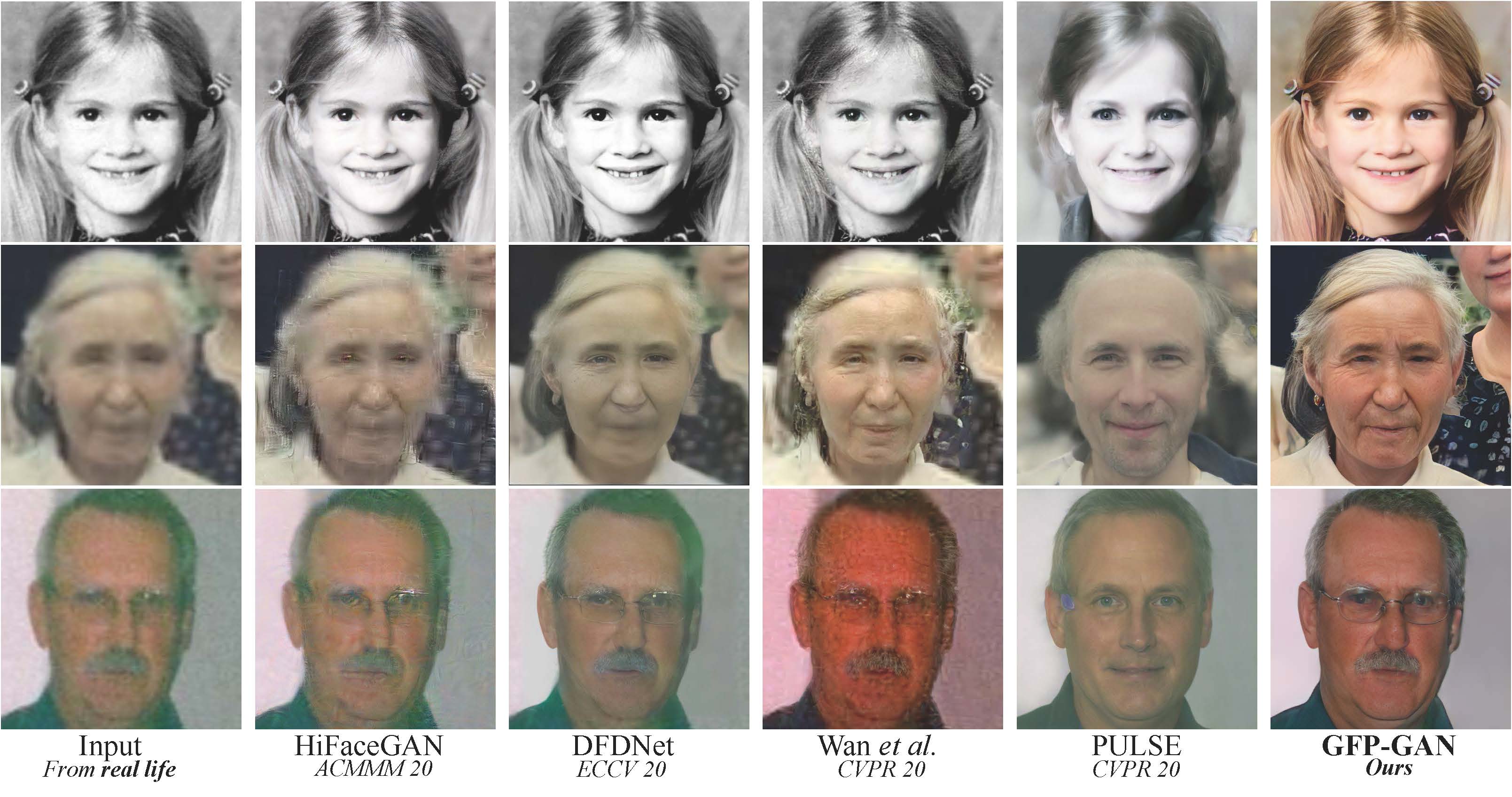- Colab Demo for GFPGAN
; (Another Colab Demo for the original paper model)
- We provide a clean version of GFPGAN, which can run without CUDA extensions. So that it can run in Windows or on CPU mode.
GFPGAN aims at developing a Practical Algorithm for Real-world Face Restoration.
It leverages rich and diverse priors encapsulated in a pretrained face GAN (e.g., StyleGAN2) for blind face restoration.
🚩 Updates
- ✅ Integrated to Huggingface Spaces with Gradio. See Gradio Web Demo.
- ✅ Support enhancing non-face regions (background) with Real-ESRGAN.
- ✅ We provide a clean version of GFPGAN, which does not require CUDA extensions.
- ✅ We provide an updated model without colorizing faces.
If GFPGAN is helpful in your photos/projects, please help to ⭐ this repo or recommend it to your friends. Thanks😊
Other recommended projects:
[Paper] [Project Page] [Demo]
Xintao Wang, Yu Li, Honglun Zhang, Ying Shan
Applied Research Center (ARC), Tencent PCG
- Python >= 3.7 (Recommend to use Anaconda or Miniconda)
- PyTorch >= 1.7
- Option: NVIDIA GPU + CUDA
- Option: Linux
We now provide a clean version of GFPGAN, which does not require customized CUDA extensions.
If you want to use the original model in our paper, please see PaperModel.md for installation.
-
Clone repo
git clone https://github.com/TencentARC/GFPGAN.git cd GFPGAN -
Install dependent packages
# Install basicsr - https://github.com/xinntao/BasicSR # We use BasicSR for both training and inference pip install basicsr # Install facexlib - https://github.com/xinntao/facexlib # We use face detection and face restoration helper in the facexlib package pip install facexlib pip install -r requirements.txt python setup.py develop # If you want to enhance the background (non-face) regions with Real-ESRGAN, # you also need to install the realesrgan package pip install realesrgan
Download pre-trained models: GFPGANCleanv1-NoCE-C2.pth
wget https://github.com/TencentARC/GFPGAN/releases/download/v0.2.0/GFPGANCleanv1-NoCE-C2.pth -P experiments/pretrained_modelsInference!
python inference_gfpgan.py --upscale 2 --test_path inputs/whole_imgs --save_root resultsIf you want to use the original model in our paper, please see PaperModel.md for installation and inference.
- GFPGANCleanv1-NoCE-C2.pth: No colorization; no CUDA extensions are required. It is still in training. Trained with more data with pre-processing.
- GFPGANv1.pth: The paper model, with colorization.
You can find more models (such as the discriminators) here: [Google Drive], OR [Tencent Cloud 腾讯微云]
We provide the training codes for GFPGAN (used in our paper).
You could improve it according to your own needs.
Tips
- More high quality faces can improve the restoration quality.
- You may need to perform some pre-processing, such as beauty makeup.
Procedures
(You can try a simple version ( options/train_gfpgan_v1_simple.yml) that does not require face component landmarks.)
-
Dataset preparation: FFHQ
-
Download pre-trained models and other data. Put them in the
experiments/pretrained_modelsfolder. -
Modify the configuration file
options/train_gfpgan_v1.ymlaccordingly. -
Training
python -m torch.distributed.launch --nproc_per_node=4 --master_port=22021 gfpgan/train.py -opt options/train_gfpgan_v1.yml --launcher pytorch
GFPGAN is released under Apache License Version 2.0.
@InProceedings{wang2021gfpgan,
author = {Xintao Wang and Yu Li and Honglun Zhang and Ying Shan},
title = {Towards Real-World Blind Face Restoration with Generative Facial Prior},
booktitle={The IEEE Conference on Computer Vision and Pattern Recognition (CVPR)},
year = {2021}
}
If you have any question, please email xintao.wang@outlook.com or xintaowang@tencent.com.





